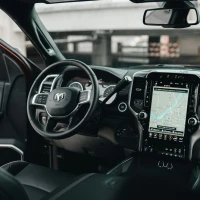As the temperature drops and snow begins to blanket the roads, driving becomes a whole new ballgame. Winter conditions can bring about a unique set of challenges for motorists, from slippery surfaces to decreased visibility. Ensuring your car is properly prepped for these conditions isn’t just a recommendation — it’s essential for your safety and the safety of those around you. In this comprehensive guide, we dive deep into the 10 Essential Vehicle Prep Tips for Winter Safety. These tips will help you Drive Confidently through the harshest winter months, ensuring peace of mind as you navigate the freeze.
Driving in winter demands preparation, awareness, and understanding. Whether you’re facing frosty mornings or braving a blizzard, each aspect of your vehicle needs to be operating at its best. We’ve got your back with insider knowledge and actionable advice — like the importance of a good set of winter tires or the power of an emergency kit — so when the mercury plummets, you won’t be left out in the cold. Keep this guide handy, and set the wheels of safety in motion as winter revs up.
Winterize Your Wheels: The Foundation of Safe Winter Driving
The Importance of Winter Tires
Winter tires aren’t a luxury—they’re a critical safety feature. Unlike all-season tires, winter tires are specifically designed to retain flexibility at lower temperatures. This allows them to maintain better contact with the road, offering improved traction.
- Look for tires with the “Three-Peak Mountain Snowflake” symbol, indicating they meet the required performance criteria in snow testing.
- Consider studded tires if you live in an area with heavy ice.
- Don’t forget to check tire pressure regularly, as it drops in cold weather.
Keeping Your Tires in Top Shape
Regular tire maintenance goes further than swapping them out seasonally.
- Inspect your tires for tread wear and replace them if necessary.
- Rotate your tires to ensure even wear.
- Check alignment to avoid inefficient tire performance leading to potential control issues.
Engine Care: Keep the Heart of Your Vehicle Beating
A Robust Battery Is a Must
Extreme cold can be brutal on your vehicle’s battery. A thorough inspection is key.
- Have a professional test your battery’s strength.
- Keep the battery terminals clean to prevent power loss.
- Consider a battery blanket for extra insulation.
Maintain Fluid Levels for Optimal Performance
Proper fluid levels are the lifeblood of vehicle health, particularly in winter.
- Check engine oil viscosity — winter might require a thinner oil.
- Antifreeze is appropriately named for winter use; ensure it’s filled to the right level.
- A windshield washer fluid with de-icer is essential for maintaining visibility.
Vision in the Snow: Ensuring Clear Visibility
Windshield Prep Is Critical
A clear view of the road is vital in snowy conditions.
- Replace wiper blades periodically to avoid streaks or gaps.
- Apply windshield treatments that repel water and resist icing.
- Repair any chips or cracks in the windshield to prevent them from worsening.
Lighting the Way
Dark, wintry conditions require optimum lighting — both for you to see and to be seen.
- Ensure all lights and indicators are functioning and clean.
- Consider upgrading to LED lights for better illumination.
- Keep your headlights properly aligned to avoid blinding other drivers.
Vital Vehicle Systems: Keep Them Functioning Flawlessly
Brake Checks: Your Best Defense Against Slips and Slides
Brakes are pivotal for driver response in icy conditions.
- Have a professional examine the brake system — pads, rotors, and fluid.
- Know how ABS (Anti-lock Braking System) works and trust it during winter scenarios.
- If your vehicle has traction control or other electronic stability aids, ensure they are functioning correctly.
Exhaust System: Keep It Clean
A clogged or damaged exhaust can be dangerous, especially when idling in winter.
- Check for leaks to avoid the risk of carbon monoxide poisoning.
- Ensure the exhaust pipe isn’t blocked by snow, which can lead to dangerous gas build-up.
The Cold Can Kill: Survival and Emergency Preparedness
Stock an Emergency Kit
Unexpected situations can arise easily in winter. Be prepared with a comprehensive emergency kit.
- Include items like blankets, a flashlight, and non-perishable food.
- Carry sand or kitty litter for traction if you get stuck.
- Keep a shovel and ice scraper handy at all times.
Stay Charged and Connected
A dead phone battery is the last thing you need in an emergency.
- Keep a fully-charged power bank in your vehicle.
- Consider investing in an in-car charger for your phone.
- Program important contact numbers into your phone and keep a written copy as well.
Heating and Cooling Systems: Comfort Meets Necessity
A Properly Working Heater Is Essential
Being comfortable isn’t just about luxury; it’s about safety, too.
- Check the function of your heater before the cold sets in.
- Ensure your defroster works to maintain visibility.
- Seal any gaps in doors or windows to keep the heat in and the cold out.
Cooling Systems Are Just as Important
The heater takes the spotlight in winter, but don’t neglect the cooling system.
- The engine working harder in colder temps means the cooling system has to work properly.
- Check hoses and belts for signs of wear that could lead to leaks.
- Keep the coolant/antifreeze mixture at the correct levels to avoid freezing and overheating.
Secure Your Cargo: Safety Outside the Vehicle
Roof Racks and Cargo Carriers
Carrying extra gear for winter sports and activities is common, but it has to be done right.
- Ensure that roof racks and cargo carriers are properly installed and that the load is secure.
- Beware of increased wind resistance impacting vehicle handling and fuel consumption.
- Regularly check the fastening of any outside cargo during your trip.
Tow Hooks and Trailer Hitches
Towing in winter can be challenging; proper equipment is necessary.
- Lubricate and check the tow hooks and hitches to prevent them from seizing due to salt corrosion.
- Test trailer lights and brakes, ensuring they are in sync with the vehicle.
In-Car Technology: Your Digital Copilot
Understand Your Vehicle’s Safety Features
Modern vehicles come equipped with a plethora of safety tech that can be particularly useful in winter.
- Familiarize yourself with features like traction control and lane-keeping assist.
- Adaptive cruise control should be used judiciously in variable conditions.
- Regularly update your vehicle’s software to ensure all systems are go.
GPS and Navigation Systems: More Than Convenience
Having a reliable navigation system can be a lifesaver.
- Keep the GPS maps and software updated for the most accurate information.
- Understand how to use offline maps if you lose signal in remote areas.
- Always have a physical map as a backup.
After the Storm: Post-Winter Recovery
Wash Away the Salt and Grime
Road salt is important for melting snow, but it’s harsh on your vehicle.
- Frequently wash your vehicle to remove salt and prevent corrosion.
- Pay special attention to the undercarriage, where salt can be particularly damaging.
Post-Winter Maintenance Is Crucial
After surviving the winter, don’t neglect vehicle maintenance.
- Schedule a thorough check-up with your mechanic.
- Check your vehicle’s alignment and suspension for any issues caused by winter driving.
- Replace any parts that are worn or damaged, so you’re ready for the next winter adventure.
Winter months present drivers with some of the most challenging road conditions, and that heightens the importance of being proactive with your vehicle’s preparedness. From winter tires that clutch at the snowy asphalt to the emergency kit that becomes your lifeline in unexpected situations, every aspect of your car demands attention. Implement these 10 Essential Vehicle Prep Tips for Winter Safety to ensure that, no matter how fierce the blizzard, you’re equipped to Drive Confidently. Stay vigilant, stay warm, and most importantly, stay safe on those winter roads.










